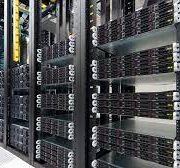Introduction
The convergence of Artificial Intelligence and Edge Computing with server technologies signifies a transformative epoch in the digital realm. This article delves into the advanced integration of these technologies, focusing exclusively on server systems. It explores the evolution, architectural considerations, and optimization of AI algorithms for edge environments. Additionally, it discusses the role of edge computing in AI-driven analytics, networking solutions, and the challenges faced during its deployment.

Cornerstones
- AI and Edge Computing are revolutionizing server technologies by enhancing data processing speeds and storage capabilities.
- Scalability, security, and interoperability are critical architectural considerations for integrating AI with edge servers.
- Optimized AI algorithms for edge computing are crucial for reducing latency and improving real-time data analysis.
- Key trends include automation of edge operations with AI assistant DevEdgeOps, AI-based edge orchestration for dynamic workload migration, and AI inferencing across edge and cloud seamlessly.
- The rise of lightweight micro-AI models optimized for resource-constrained edge devices and the emergence of new edge-optimized AI frameworks and models are expected to drive innovation.
The Evolution of Server Technologies with Edge AI
Historical Perspective and Recent Developments
The integration of AI and edge computing marks a significant evolution in server technologies. Initially, data centers were centralized hubs, but the demand for real-time data processing has shifted the focus toward decentralized architectures. As AI burgeons into the linchpin of global economies, data centers cease to be mere repositories of servers and CPU tasks, instead metamorphosing into crucibles of innovation, nurturing large language models (LLMs) on sprawling enterprise datasets.
The demand for data centers has transcended tech behemoths, permeating through large enterprises, governmental bodies, and the expanse of smart cities, each clamoring for specialized facilities to orchestrate their burgeoning AI workloads. The hegemony of Nvidia in the GPU market for AI training faces formidable challengers in the form of Intel and AMD, catalyzing a diversification of the GPU field and bestowing data centers with enhanced flexibility and cost-effectiveness.It must be noted that the imperative for energy efficiency has emerged as an existential mandate, propelling data centers toward sustainable practices encompassing advanced cooling technologies, renewable energy adoption, and energy-efficient hardware.
Key Technologies Driving Change
Recent advancements in key technologies such as Internet of Things (IoT) devices, cutting-edge neural networks, and real-time data processing capabilities have become instrumental in shaping server dynamics. These technologies enable servers to conduct localized processing and analysis of data, significantly reducing latency and enhancing operational efficiency.
Latest Technological Insights
1. Quantum Computing: The integration of quantum computing with edge servers promises unparalleled processing power and computational capabilities. Quantum computing’s ability to perform complex calculations and solve optimization problems at lightning speeds opens up new frontiers in AI-driven analytics and decision-making.
2. Federated Learning: Federated learning allows edge devices to collaboratively train machine learning models without sharing raw data. This privacy-preserving approach facilitates decentralized model training, enabling edge servers to leverage insights from diverse datasets while respecting data privacy regulations.
3. Neuromorphic Computing: Inspired by the human brain’s architecture, neuromorphic computing mimics biological neural networks to achieve unprecedented energy efficiency and computational speed. By harnessing neuromorphic processors, edge servers can execute AI algorithms with remarkable efficiency, paving the way for intelligent edge applications.
4. Edge-native AI Accelerators: Custom-designed AI accelerators tailored for edge environments optimize inference tasks and enhance edge server performance. These specialized accelerators leverage hardware acceleration to accelerate AI workloads, enabling edge servers to deliver real-time insights and responses.
5. Distributed Ledger Technology (DLT): Integrating distributed ledger technology with edge servers ensures data integrity, transparency, and immutability in decentralized environments. DLT-powered edge servers enable secure and tamper-resistant data transactions, bolstering trust and reliability in edge computing ecosystems.
Impact on Data Processing and Storage
The shift toward edge computing has dramatically altered how data is processed and stored. Traditional cloud storage is now complemented by edge devices that perform initial data processing. This dual approach ensures faster access to processed data and reduces bandwidth usage. Edge computing is set to become even more powerful and accessible, with the transition from on-site to cloud, equipping even the smallest devices with significant processing capabilities.
Architectural Considerations for AI-Enhanced Edge Servers
Designing for Scalability and Efficiency
In the realm of AI-enhanced edge servers, designing for scalability and efficiency is paramount. These servers must handle varying loads and adapt to changing demands without compromising performance. Efficient resource management strategies like dynamic resource allocation are essential.
Security Challenges
Security remains a critical concern in edge computing architectures. The proximity of edge servers to data sources can enhance security but also poses unique challenges. Solutions include advanced encryption protocols and continuous security updates to protect against evolving threats.
Interoperability Between Diverse Systems
Achieving interoperability between diverse systems is crucial for seamless functionality in AI-enhanced edge environments. This involves standardizing communication protocols and ensuring that different devices and platforms can effectively interact. Strategies such as adopting universal APIs and middleware solutions are often employed.
Developing AI Models for Low-Latency Environments
In the realm of edge computing, developing AI models that can operate under low-latency conditions is crucial for performance. These models must be lightweight yet powerful enough to process data in real-time, ensuring timely decisions and operational efficiency.
Case Studies: Successful Implementations
Several organizations, as exemplified below, have successfully implemented Edge AI, showcasing significant improvements in responsiveness and cost efficiency.
1. Siemens’ Edge Computing Initiative in Manufacturing
Siemens introduced the Industrial Edge Ecosystem two years ago, revealing a digital marketplace that facilitates the deployment of third-party apps on the Siemens Industrial Edge Platform. This initiative allows customers to access a wide range of software components from various providers, streamlining their integration into manufacturing processes. Through the Industrial Edge Marketplace, users can conveniently select, purchase, and utilize software, similar to the experience of consumer app stores.
The platform not only offers Siemens Edge apps but also welcomes third-party providers like Braincube, Cybus, SeioTec, and Tosibox to showcase their products. This diversity enables customers to benefit from a broad spectrum of solutions, covering connectivity, data storage, visualization, analysis, machine monitoring, energy management, and asset management. One of the key advantages of Industrial Edge is its ability to enable Edge Computing, which enhances the agility and adaptability of industrial automation systems. By processing data locally at the edge of the network, companies can optimize resource utilization, improve productivity, and respond to real-time insights more effectively. Siemens’ Edge-capable devices, such as the Simatic HMI Unified Comfort Panel, exemplify this capability, offering extendable functionalities through apps.
2. AWS Greengrass: Facilitating Edge Computing for IoT Devices
The advent of Edge Computing has transformed the world of IoT devices, and one notable facilitator of this transformation is Amazon Web Services (AWS) Greengrass. This robust platform extends AWS cloud functionalities to IoT devices, empowering them to locally process data, execute AWS Lambda functions, and communicate securely with the cloud, even without internet connectivity. This capability proves invaluable for IoT applications requiring immediate responsiveness, minimal latency, and optimized bandwidth usage. For industries, Greengrass supports functions like predictive maintenance, anomaly detection, and local decision-making at the edge, thereby enhancing efficiency and reducing downtime.
Moreover, AWS has collaborated with NXP Semiconductors, a leading provider of edge computing solutions, to offer a comprehensive cloud-to-edge machine learning solution. This collaboration combines AWS IoT Greengrass, Amazon SageMaker, and NXP applications processors, enabling organizations to address challenges in edge application performance monitoring and analysis. By working together, AWS and NXP provide customers with a holistic solution for monitoring and optimizing edge applications effectively. The integration of AWS Distro for OpenTelemetry with AWS IoT Greengrass further enhances observability capabilities, allowing organizations to collect and export telemetry data from both edge and cloud applications seamlessly. This integrated approach offers real-time visibility into application performance, enabling data-driven decision-making to enhance customer experience and drive business growth.
3. Microsoft Azure Edge: Customized Edge Computing Solutions for Industrial Automation
Microsoft Azure Edge stands at the forefront of revolutionizing industrial automation and manufacturing sectors through tailored edge computing solutions. With Azure IoT Edge, businesses gain access to a comprehensive suite of services enabling seamless deployment and management of edge modules. This facilitates data processing, analytics, and machine learning inference at the edge, empowering industries to unlock real-time insights for predictive maintenance, quality control, and process optimization.
By bringing intelligence closer to data sources, Azure Edge services elevate operational agility, reliability, and productivity in industrial settings. This strategic positioning enables industries to respond swiftly to dynamic market demands, drive innovation, and enhance overall efficiency. Moreover, Azure Edge addresses critical challenges in data-driven manufacturing, offering solutions to overcome compliance requirements and interoperability constraints.
In a recent case study, Dutch paint company AkzoNobel and Swedish manufacturer Sandvik Coromant exemplified the transformative impact of Azure Edge solutions. AkzoNobel transitioned from manual operations to a digitally empowered environment across its European factories, while Sandvik Coromant experienced a significant boost in engineering and operator productivity. These success stories underscore the immense potential of Azure Edge in driving tangible business outcomes and fostering industry-wide innovation.
4. Empowering Industrial Automation with Dell’s Edge Computing Solutions
NativeEdge, a cutting-edge edge operations software platform seamlessly integrates with any AI solution, IoT framework, or multi-cloud environment. With its open design and zero-trust architecture, NativeEdge ensures the integrity and security of the entire edge estate, laying the foundation for robust and reliable operations.Central to Dell’s edge ecosystem are their ruggedized and compact edge servers, purpose-built to meet the demands of edge deployments. These servers play a pivotal role in hosting AI models directly, enabling real-time inference without the need for constant cloud connectivity.
Whether it’s a smart factory optimizing production or an autonomous vehicle making split-second decisions, Dell’s edge servers provide the computational power needed to drive intelligent edge applications.Complementing the edge servers are Dell’s edge gateways, serving as vital data aggregation points within the network. By preprocessing data and applying AI algorithms at the gateway, organizations can reduce the volume of raw data transmitted to the cloud, resulting in faster insights and minimized cloud costs.
The Role of Edge Computing in AI-Driven Analytics
Real-Time Data Analysis at the Edge
Edge computing enables the processing of data where it is generated, significantly reducing latency and enhancing the responsiveness of AI applications. This capability is crucial in scenarios where real-time decision-making is essential, such as in autonomous vehicles or emergency response systems. The immediacy of data processing at the edge can be the difference between a timely and a delayed response.
Enhancing Decision-Making Processes
By decentralizing data analysis, edge computing allows for more dynamic and context-aware decision-making. This shift not only speeds up the process but also enhances the accuracy of the outcomes. For instance, in healthcare, real-time analytics can lead to quicker diagnoses and more personalized treatment plans, directly impacting patient care quality.
By decentralizing data analysis, edge computing allows for more dynamic and context-aware decision-making. This shift not only speeds up the process but also enhances the accuracy of the outcomes. For instance, in healthcare, real-time analytics can lead to quicker diagnoses and more personalized treatment plans, directly impacting patient care quality.
Applications in Various Industries
Edge computing has a broad range of applications across different sectors, such as,
- Precision agriculture: optimizing irrigation and detecting pests
- Manufacturing: monitoring equipment performance to predict maintenance needs
- Retail: enhancing customer experience through personalized offers and optimized inventory management
- Healthcare: supporting remote monitoring and diagnostic tools
Edge computing’s versatility demonstrates its potential to revolutionize multiple industries by enabling smarter, faster, and more reliable data analytics.
Networking and Connectivity Solutions for AI-Edge Integration
Advancements in Network Infrastructure
The evolution of network infrastructure is pivotal in supporting the integration of AI and Edge computing. Enhanced network capabilities ensure that data can be processed efficiently at the edge, reducing latency and increasing the responsiveness of AI applications. Key advancements include the deployment of more sophisticated routers and switches, and the expansion of bandwidth capabilities.
5G and Beyond: Accelerating Edge Capabilities
The rollout of 5G technology is a game-changer for edge computing. It offers significantly higher speeds and lower latency, which are crucial for real-time AI processing. Future technologies, such as 6G, promise even greater improvements. These advancements are not just enhancing current capabilities but are also setting the stage for more innovative applications that can leverage real-time data processing.
5G and edge computing are poised to revolutionize application performance and enable real-time data processing. 5G boosts speeds by up to ten times that of 4G, while edge computing reduces latency by bringing compute capabilities closer to users.5G’s latency targets, set at 1ms network latency, necessitate mobile edge computing for their achievement. Telecom operators are investing heavily in 5G, with speeds reported to be more than twenty times faster than LTE in lab settings, although real-world experiences may differ.
The 5G rollout varies globally, with enthusiasm and investment concentrated in regions like the US, China, Korea, and Japan. European operators, while participating in the 5G rollout, are more cautious, focusing on LTE advancements as a stepping stone to 5G.
5G and edge computing offer complementary benefits for data-intensive applications like AI, cloud gaming, and autonomous systems. Edge computing enhances the performance of 5G by reducing data travel distance, resulting in improved application performance and reduced latency. This combination is vital for real-time applications, enabling them to ‘think’ in real-time.
5G and edge computing also have environmental benefits, with 5G networks consuming less energy than previous generations. Edge computing further reduces energy consumption by filtering and analyzing data locally before sending it to the central cloud. Moreover, edge computing reduces the cost of delivering 5G-enabled applications by minimizing data travel to the central cloud, resulting in lower energy expenses for network providers. These cost efficiencies can be passed on to end-users, making new technologies more accessible financially.
Ensuring Robust and Secure Connections
Security remains a top priority as the deployment of edge AI systems expands. Robust security protocols are essential to protect sensitive data and maintain user trust. Implementing advanced encryption methods and continuous security monitoring are steps that can help maintain the integrity and security of data as it moves across various points in the network.
Challenges in Deploying Edge AI
Addressing Resource Constraints
Deploying AI models at the edge often faces significant resource constraints, including limited processing power, memory, and energy availability. Optimizing resource allocation is crucial to ensure efficient operations without compromising performance. Strategies such as model pruning, quantization, and lightweight algorithm design are essential.
Balancing Cloud and Edge Computing
The integration of cloud and edge computing presents a unique set of challenges. It’s vital to determine the optimal balance for processing tasks. Tasks that require immediate action are best processed at the edge, while more complex analyses can be deferred to the cloud. This balance ensures responsiveness and leverages the full potential of both environments.
Future Prospects of AI and Edge Computing
The integration of AI with edge computing is poised to transform market dynamics significantly. Global spending on edge computing is projected to reach $232 billion in 2024, marking a 15.4% surge compared to 2023, as per the latest forecast by the International Data Corporation. This growth is fueled by the increasing demand for real-time data processing and enhanced operational efficiency.
Geographically, North America is projected to lead edge spending, capturing over 40% of the worldwide total share, followed by Western Europe and China, with China and the Middle East & Africa experiencing the fastest spending growth rates over the forecast period. The future of server systems looks promising with continuous advancements in AI and edge computing, promising more robust, scalable, and intelligent infrastructure.




















Comments